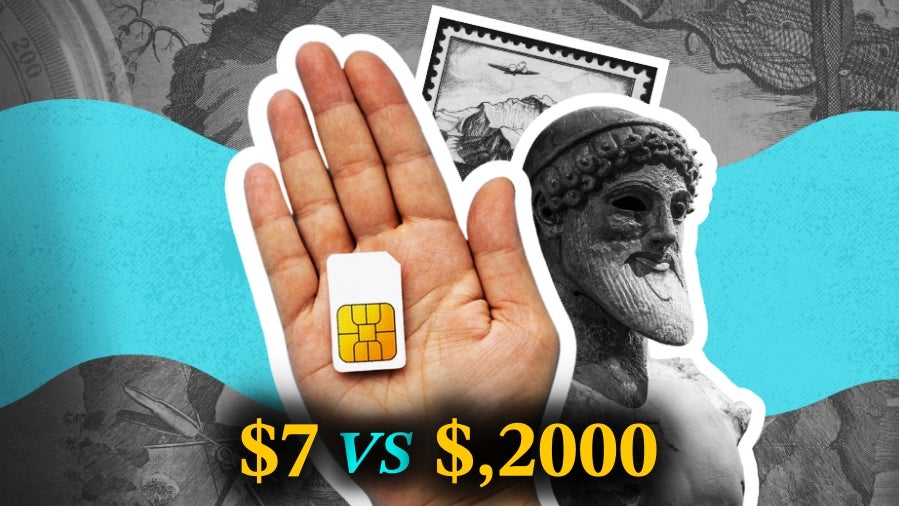Buying a $7 eSIM for a holiday overseas saved my family $2,000 worth of roaming charges
This article may contain personal views and opinion from the author.

In case you missed Alan’s super popular story about a family going on an overseas vacation, and receiving a $78K monthly bill from T-Mobile for a few days of data roaming, I’m here to tell you that you could be next! So, if you don’t have $78,000 burning a hole in your pocket, you better keep reading…
Coincidence or not, I recently returned from a trip to Istanbul, Turkey, which isn’t part of the European Union. Even though a good chunk of Istanbul is within European borders, a 5-minute boat ride across the Bosphorus takes you to the Asian side of the ancient city. You’d be shocked to find out but the Asian side is in… Asia.
All of this means my O2 SIM from England wasn’t going to take me very far in Turkey. Especially since I’m on a pre-paid SIM, because I’m an absolute… I believe the word is “baller”.
I instantly thought of my not-so-recent trip to Morocco (Africa), when I bought a local SIM and popped it in my iPhone 8, which I used as my secondary, “Moroccan” phone, which worked out perfectly fine.
I Googled it, but unlike in Morocco, where the local SIM I bought must’ve been cheaper than $5 (including 1GB of data), the prices for Turkish SIM cards (or at least the ones for tourists) started at $40-50. Goes without saying, the baller with the pre-paid O2 SIM wasn’t falling for that perfectly legal tourist trap.

Once I knew buying a Turkish SIM was more expensive than a 4-night hostel stay in Istanbul, I went back to Googling, when I was eventually reminded of the existence of something called… eSIM. You know - the last major “feature” Apple forced on iPhone users in the US?

If you went back to Alan’s story about the family who racked up a $78K T-Mobile bill, you’ll see that many people on Reddit suggest all you need to do to make sure you don’t get a similar roaming bill is to “turn on Airplane mode” (to make sure your SIM isn’t active). But this doesn’t solve your other major problem - you still need internet access when traveling.
That being said, eSIM cards aren’t quite ubiquitous just yet, and I still want to know that I can buy a cheap local SIM in regions of the world where eSIM isn’t an option, which makes me think about the eSIM-only iPhones Apple now sells in the United States…
For example, Airalo’s eSIM services cover about 65% of the countries around the world (124 to be specific). And during my trip to Morocco, the local SIM I picked up in Marrakech was a lifesaver (and incredibly affordable as mentioned earlier).
Although I must say my Morrocan friend had to help me set it up (you call the robot, and then the robot says stuff in Arabic/French). You wouldn’t encounter this problem with an eSIM, which is another reason eSIM is better for traveling abroad. However, Airalo’s Moroccan eSIM is also more expensive - so, there’s that.
I instantly thought of my not-so-recent trip to Morocco (Africa), when I bought a local SIM and popped it in my iPhone 8, which I used as my secondary, “Moroccan” phone, which worked out perfectly fine.
I Googled it, but unlike in Morocco, where the local SIM I bought must’ve been cheaper than $5 (including 1GB of data), the prices for Turkish SIM cards (or at least the ones for tourists) started at $40-50. Goes without saying, the baller with the pre-paid O2 SIM wasn’t falling for that perfectly legal tourist trap.
#This Is Not an Ad: My experience with using an Airalo eSIM in Turkey changed my view on eSIM cards

And that’s when I discovered Airalo! (*unskippable YouTube ad voice)
- The price I paid for my Airalo eSIM? Only $7, with a whopping 3GB of data… Again, that’s compared to the $40-50 I would’ve paid for a physical SIM card in Turkey
- To be fair, since it was my first time setting up an eSIM on my iPhone, I found the process to be a bit daunting; you first have to download the eSIM provider’s app; then you go into the app and follow what feels like 15 steps worth of instructions; this includes having to fiddle with the SIM, roaming, and data settings on your phone, and after some 5-10 minutes (depending on how “tech savvy” you are), hopefully you’ve done it correctly…
- Something worth pointing out is that the process of setting up my first eSIM seemed a bit more straightforward on Android (specifically a Pixel phone) than it did on my iPhone; I’m saying that, because it’s usually the other way around - apps tend to be better “optimized” for iPhone; otherwise, the setup process is pretty similar
- Either way, once your eSIM is *correctly* installed, you’re good to go - all I had to do after landing in Istanbul was to head into my iPhone settings and turn on the Airalo eSIM; the absolutely CRUCIAL part here is to make sure your regular SIM is turned OFF, so your phone doesn’t automatically switch to it - unless you got that *roaming money*, of course
- From that moment on, it was just like using my normal SIM, except this one didn’t come with a phone number (some of them do, apparently), meaning the only phone calls I could make were via WhatsApp, Messenger, iMessage, etc. (which usually works out just fine in 2024)
- In case you’re wondering, as long as they are set up beforehand, apps that require your regular phone number, from your regular SIM card (WhatsApp, Uber, etc.), should work just fine; I was able to get an Uber with my normal Uber account (which uses my regular phone number) while using the Airalo eSIM (the Turkish Uber driver turned out to be a con artist but that’s a different story)
- And in case you’re wondering about “how much data is enough data”, 3GB were more than enough for an entire week of heavy Google Maps-ing, internet browsing, and WhatsApp-ing for me; all in all, as long as you avoid watching long-form (YouTube) video, 3GB suddenly feels like 30GB
- In case you do run out of data, topping up is as easy as going into the Airalo app and purchasing as much data as you think you’ll need - it’s like ordering another pizza if the family pizza you ordered for yourself wasn’t enough… just me?!
Cheap eSIM cards are amazing when traveling abroad, but the iPhone should still support a physical SIM, Apple

All in all, the reason I’m sharing this positive experience with my first-ever eSIM card is because people clearly need to hear this advice, and learn about eSIM, which isn’t the futuristic “technology of tomorrow” it seemed like five years ago. It’s usable and useful right now!
If you went back to Alan’s story about the family who racked up a $78K T-Mobile bill, you’ll see that many people on Reddit suggest all you need to do to make sure you don’t get a similar roaming bill is to “turn on Airplane mode” (to make sure your SIM isn’t active). But this doesn’t solve your other major problem - you still need internet access when traveling.
A few years ago, my aunt took another week-long trip to Turkey, when she thought that using her German SIM for data was going to be a seamless experience. And it was - it worked flawlessly for her, her husband, and their son. Until they were back in Germany to receive their $700 bill for “roaming” around outside of Europe. Had I made the same mistake, my family’s phone bill for a week in Turkey likely would've come up to some $2,000.
That being said, eSIM cards aren’t quite ubiquitous just yet, and I still want to know that I can buy a cheap local SIM in regions of the world where eSIM isn’t an option, which makes me think about the eSIM-only iPhones Apple now sells in the United States…
Although I must say my Morrocan friend had to help me set it up (you call the robot, and then the robot says stuff in Arabic/French). You wouldn’t encounter this problem with an eSIM, which is another reason eSIM is better for traveling abroad. However, Airalo’s Moroccan eSIM is also more expensive - so, there’s that.
eSIM cards will only be getting more popular as more smartphones adopt eSIM exclusively. This is already true for newer iPhones sold in the United States, but if I had to guess, the eSIM transition will take a bit longer in the rest of the world. To be honest, I'm happy to know I can always pop a physical SIM card into my iPhone. Perhaps the US government can add this to the big Apple lawsuit?
Follow us on Google News














Things that are NOT allowed:
To help keep our community safe and free from spam, we apply temporary limits to newly created accounts: